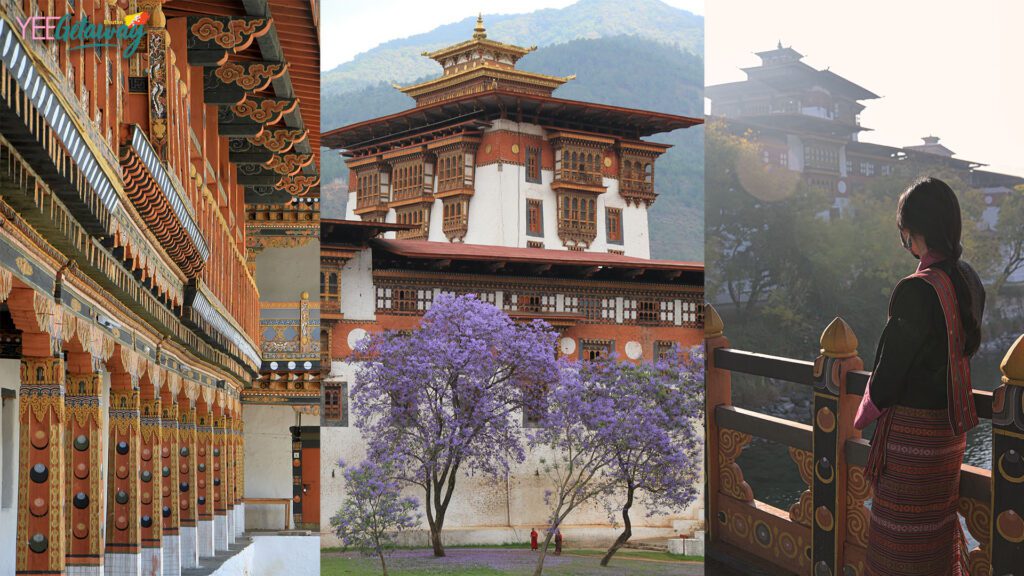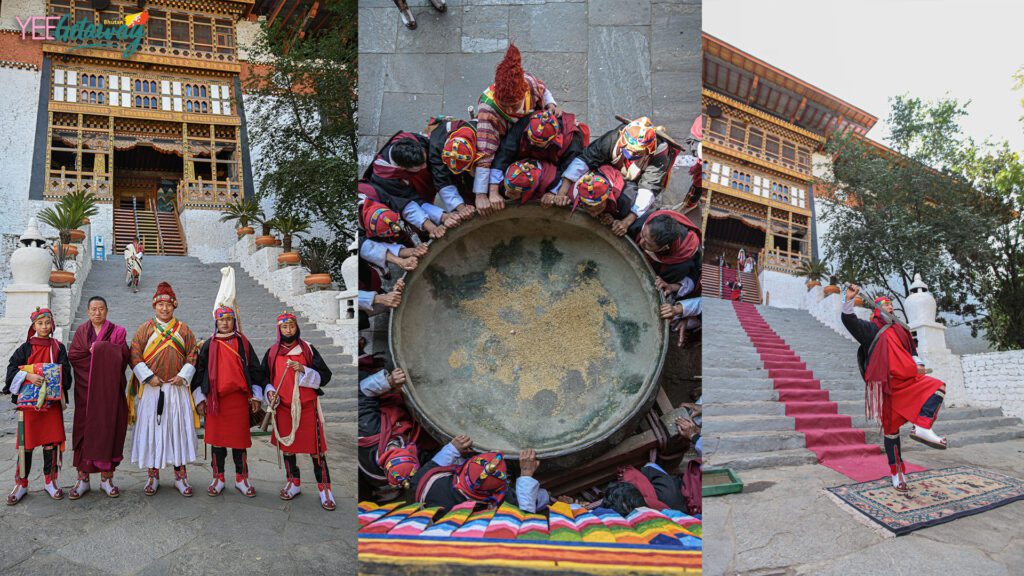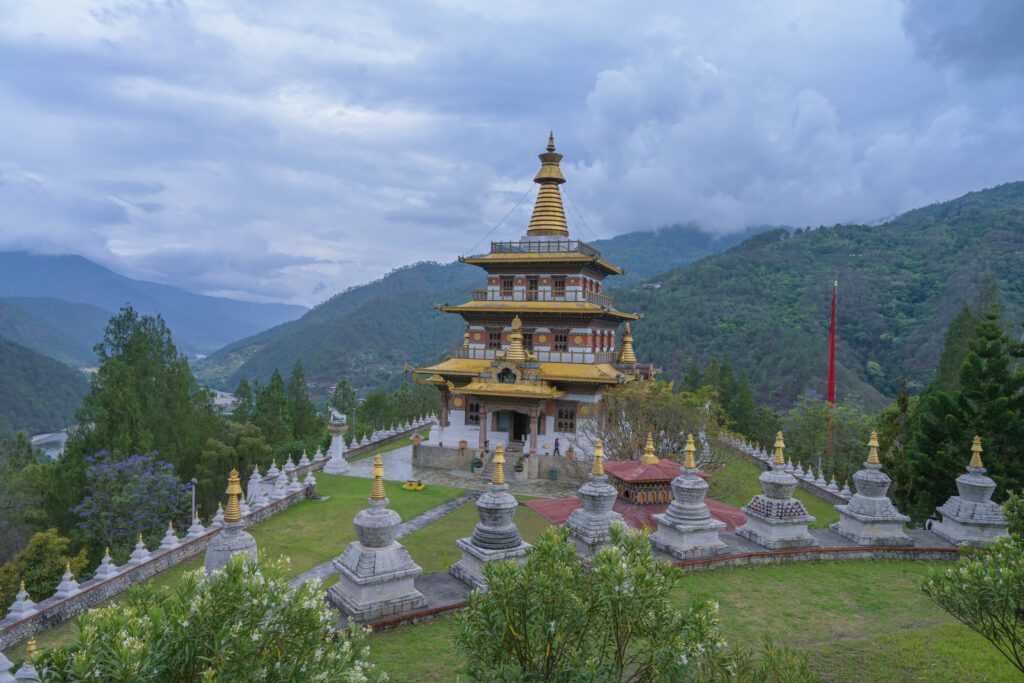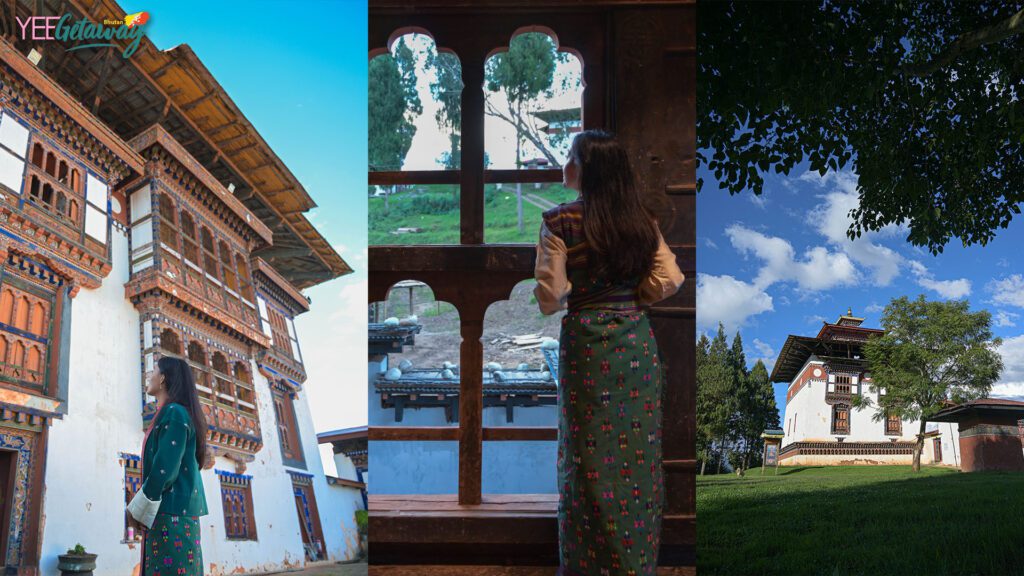
The picturesque valley of Punakha is located in western Bhutan. It is renowned for its villages surrounded by rice fields, stunning Bhutanese architecture, fertile land that grows a variety of fruits and vegetables and warm weather. Additionally, the Mo-chu and Pho Chu rivers’ meandering course adds to its attractiveness. If you’re visiting Punakha district, here are a few things you can do during your trip to the warm valley.

1/ Marvel at Traditional Architecture embodied in Punakha Dzong
If you love travelling to marvel at traditional architecture then you’ll love getting a glimpse of the Punakha Dzong fortress sitting near the confluence of two rivers becoming one.
A triumph of traditional Bhutanese architecture, Punakha Dzong is also known as Pungthang Dewa Chhenbi Phodrang. It means ‘the palace of great bliss’. It is believed that Guru Rinpoche foretold the construction of this monument. And that Zhabdrung Ngawang Namgyal (The Great Unifier) would later build at the confluence of two raging rivers. Legend also says that the architect Zow Palep woke up with the blueprint of the dzong in his mind, after sleeping under the statue of Buddha. The dzong was the administrative center and seat of the government till 1955. Due to its warm temperatures, Punakha is still the symbolic winter capital of the country.
What is the fortress’ significance? The Je Khenpo (Chief Abbot) and his entourage of monks move here every year as the icy winter descends on Thimphu. Punakha Dzong is where the Kingdom saw the coronation of our Kings. This is also the location of the celebrated marriage of the Fifth King to Queen Jetsun Pema. Interesting exterior attractions of the dzong include bold white-washed walls, a six-storied central tower and three courtyards- one of which houses the preserved remains of both Zhabdrung and Terton Pema Lingpa.
Punakha Dzong is also home to the most treasured relic in all of Bhutan- the Rangjung Kharsapani, a self-created image of Avalokiteshvara formed from the first vertebra of Tsangpa Gyarey.
2/ Phallus haven on your way to Chimmi Lhakhang
Walking towards this temple is unlike any other temple visit in Bhutan. How? You’ll be greeted by gigantic paintings of phalluses, hanging wooden phalluses and even more phalluses in the small handicraft shops on the way. These all take you to Chimmi Lhakhang, the Temple of Fertility.
Standing on a small hill, Chimi Lhakhag was built by Ngawang Chogyel on the site blessed by the ‘Divine Madman’ Drukpa Kinley in 1499. History has it that Drukpa Kinley subdued a demon with his “magic thunderbolt of wisdom” and stuck it in a rock at the location, close to where the lhakhang currently stands. The wooden symbol of phallus that the Lama brought from Tibet is found in the temple. The wooden phallus has a silver handle and is used to bless people, especially women, seeking blessings of fertility.
As part of tradition, the monks strike pilgrims on the head with a 25 cm wooden phallus. Women hoping to conceive are asked to carry a wooden phallus around the lhakhang three times.
The temple is famous for fertility so be prepared to see a lot of phallic symbols all the way to the temple. From the souvenirs in the shops along the way to the site or the gigantic phallus paintings on the wall of the houses. It is quite a sight.

3/ Celebrate Ancient Rituals at Punakha Domchoe
If you were to select a few traditional festivals to visit in Bhutan, then Punakha Domchoe would be on the top five. It is a series of events filled with religious ritual showcases, blessings, to theatrical performances unlike any other festival in the country. The Punakha Domchoe is a three day event dedicated to Bhutan’s guardian deities, Mahakala and Pelden Lhamo. It celebrates Zhabdrung Ngawang Namgyel’s victory over the invasion from Tibet. One characteristic of this event is the re-enactment of the battle scene in the 17th century with the Tibetan armies when they had invaded Bhutan to capture the sacred relic , Rangjung Khasapani. A self-created image of the Chenrezig. It is said that Zhabdrung outwitted the Tibetans by pretending to throw away the relic in the river Mo Chhu, whereby the Tibetan Armies retreated back .
Unlike most festivals that take place inside the fortresses, this warrior festival has a unique theatrical presentation and is one of the few events that are actively participated by civilians instead of the monk body. From the warrior clan arrival from the different communities to the dramatic entry with explosions of crackers and loud exclamations, the performance of the Pazaps are indeed worth a watch.
Be careful of the explosive crackers the performers often throw towards the crowd. You’ll need to find a decent seat in the swarm of local crowds who gather as early at 5 am to have a seat in the courtyard.
4/ Hike Towards the Serene Khamsum Yulley Namgyal Chorten

If you want to hike in Punakha valley, enjoy the beautiful vast landscape, and visit a local temple then this place is for you. Khamsum Yulley Namgyal Chorten is also called Nyizergang Chorten and Punakha Zangdopelri. It was built in 2004 by Her Majesty The Queen Mother, Ashi Tshering Yangdon Wangchuck. The chorten was established with the intention of bringing peace in the world and to clear obstacles faced by the country. Unlike most temples, Zangdopelri’s have a unique design style that encompasses the elevation layers of a stupa and the interiors of a temple. Walk up the spiral staircases that take you to the top of the structure, you’ll rewarded with the most stunning view of Punakha valley’s rice fields, scattered village houses and surrounding mountains.
Be sure to wear a cap, hydrate and dress lightly if you’re hiking during the warm months. It can get unbearably hot during the hike.
5/ Sangchen Dorji Lhuendrup Lhakhang
The Lhakhang is a temple and a nunnery located on a ridge overlooking Toebesa in Punakha. The temple bears a resemblance to Budhanath Stupa in Nepal. It also has a 14-foot bronze statue of Avalokiteshvara (Chenrezig Chagtong Chentong) and other statues of Guru Padmasambhava, Gautama Bhuddha, Zhabdrung Ngawang Namgyal, Tesla Namsum, the 21 Taras and Tsepamay (Buddha of longevity). Along with religious studies, the nuns also learn tailoring, embroidery, statue making and thangka painting. The site of the lhakhang offers breathtaking 360 degree views of the entire Punakha valley.
Built as a Buddhist College, there are currently around 120 nuns living here. The nunnery sheds light on the lives of these women who have dedicated themselves to a life of spirituality and religious instruction. Visitors have the rare opportunity to speak to the nuns and meditate with them.
Travelers can visit the lhakhang between 6 am to 6 pm. Besides the temple, spend some time visiting the artistic classes of the nuns who are studying sculpture and traditional painting. The garden and the temple property also have different pockets of beautiful view points that give you a panoramic view of Punakha valley and its surrounding mountains.
6/ Jigme Dorji National Park
Altitude- 1400-7000 m above sea level
The Jigme Dorji National Park is named after the late Jigme Dorji Wangchuck, the Third King of Bhutan. The park is the second largest in the country and occupies northern parts of Punakha. Established in 1974, the park stretches over an area of 4316 km and includes all three climatic zones of the country. The sanctuary is home to 37 species of mammals, including endangered species such as Takin, snow leopard, bengal tiger and red panda. It also has more than 300 species of birds. Interestingly, this is the only park which has the national flower (Blue Poppy), bird (Raven), tree (Cypress) and animal (Takin) coexisting together.
The park is an excellent place for nature lovers to observe rare species in their natural habitat. The route also takes travelers through significant cultural sites.
Trek in good hiking gear and contact local travel agents to plan your trekking trip for necessary trekking and route permits.
7/ Nobgang Village

Nobgang is a unique community tourism, managed entirely by locals, where you can have the singular experience of being immersed in the food, tours, hikes and homestays of Nobgang village. Nobgang is the home of our beloved Queen Mothers and has been identified by the Department of Culture for its historical significance. One of the defining characteristics of the village is their unique house designs locally known as Kabu-Dharcham. Nobgang dates its history to the 18th century, when 9th Je Khenpo Shakya Rinchen was meditating at Jachong Karmo, a cliff north of the valley. He noticed a light coming from a distance and as he went near it, he found out that the light was emanating from a gem. Hence, the village came to be known as Nobgang or ‘Gem hill’. Today, this once humble village has been re-energized by the efforts of locals to create a ‘vibrant and self-sustained Nobgang community’.
The village has a restaurant managed by the community. Nine out of 127 households in Nobang have been registered as a cooperative called Nobgang Tsherim Tshogpa. The project is also working on branding the village and developing a logo to promote Nobgang.
Try authentic local food from homestays. The flavor of these homemade regional dishes are not easily replicated in hotels and restaurants.

8/ Unique Cuisine of Punakha
Punakha’s specialty is the most famous maekhu, a crispy snack made from rice powder that resembles a ballooned crispy Indian Puri. The authentic maekhu originates from Nobgang village. Actually there are two types of maekhu, one is round and puffed called Boku Maekhu and made from pure Tan Tshering and Ngabja rice grown in Punakha. The other maekhu is flat and resembles an Indian papad is known as Luma (wind) maekhu because it’s said to be so light that a gust of wind can blow it away. Another speciality is Jatsa Gondo. This dish is a speciality of the region and involves pouring an egg mixture through a jatsha (sieve) into a pan of hot oil, turning it into a cluster of crispy eggs.
Jatsha gondo is especially made during festivals, rituals and family events. Maekhu can be eaten as a snack, beloved by local children. Although meakhu is found on the Thimphu-Wangdue Highway, they are hard and not as crispy as the ones made in Nobgang.
Go to Nobgang page on Facebook and Instagram and book your table for a unique local food experience in the village of Nobgang. You can also book a stay there and explore hiking trails around the region with a beautiful view of the valley and dzong below.

9/ Homestays in Punakha
One of the unique features of Punakha homestays are their abundant gardens. The tropical weather of the valley blesses the land with the growth of luscious fruits and vegetables, unlike any other part of the country. You can go fruit-picking in the early morning and enjoy the baskets of your fresh bounty for breakfast. The locals practice organic farming without any harmful chemicals, so you know that all the produce is fresh and healthy. Speaking of freshness, the farm to table food you try here will astound you with its fresh and rich flavors.
In a homestay you will get the opportunity to live like a typical Bhutanese- eating the everyday food, helping with chores and maybe even learning a few dzongkha phrases. Nothing beats the feeling of coming home to a family after a long journey and Punakha can be your home away from home.
Gatshothang homestay, Dhumrah farm resort, Ama Homestay and Leki Wangmo Homestay are some of the most recommended authentic farm experience accommodations in Punakha.
10/ Punakha Suspension Bridge
The Punakha suspension bridge is the longest of its kind in Bhutan. Measuring upto a 180 m in length, the bridge provides an excellent view of the Po Chhu river and the Punakha valley. The history of this bridge traces back to 1637 when Punakha was the capital of the country. It is believed that the bridge was built by the famous iron bridge builder Thangtong Gyalpo and was originally constructed to connect Dzong to the villages on the other side of the Pho Chhu. Traditionally, bridges have always been a means for the people to travel from one place to another.
The suspension bridge is adorned with bright colorful prayer flags that swings to and fro in strong winds. They say walking on the Punakha Suspension Bridge is for adventurous souls. You will also come across many locals and monks who traverse daily on this bridge.
Be careful while crossing the bridge and hold on to your phones and gadgets, especially when it gets windy on the bridge.
For more recommendations and destination travel tips click here